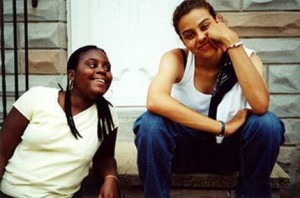The documentary “Girlhood” follows the lives of two girls, Shanae and Megan, from 1999-2002, during and shortly after their release from Waxter Juvenile Facility in Maryland. At the beginning of the documentary, Shanae and Megan are 14 and 16, serving time for murder and assault, respectively. The title of the film is overly simple and, to an extent, revealing in its simplicity.
The documentary, indeed, treats “girlhood” as its subject – a phase of life distinct from womanhood, childhood or any other experience. In an interview with NPR, the film’s director, Liz Garbus, admits that “Girlhood” was originally a documentary about incarcerated boys, but the girls’ stories were more interesting to her. Garbus’ interest in and empathy for her subjects and, more importantly, the way in which she relays their girlhood, makes for an entertaining and emotional documentary, but perhaps an incomplete one. Throughout the film, we are sympathetic to the challenges of Shanae and Megan’s girlhoods, but cannot substantively grasp, through the documentary, the unresolved nature of their status, as girls in a system that seeks to destroy not just girlhood, but life beyond girlhood too.
“Girlhood” misses some of the nuance of the girlhoods that it seeks to document in a few ways. The girls’ crimes obviously color their experiences of girlhood, but they are humanized by Garbus’ editorial choices – through camera angles, the stories we hear, the presentation of various sympathetic or irresponsible adults that accessorize and control the girls’ lives. Humanizing those who have committed crimes– especially children – is a good thing to do, and certainly expands the viewer’s capacity to embrace complicated narratives and emotions. But Garbus’ way of humanizing, in some instances, obfuscates the complexity of struggle, survival and the “bad” from the girls’ girlhood. In Garbus’ film, Shanae and Megan’s girlhood set up a dichotomy: girlhood is good, everything else threatening, extraneous and intrusive, instead of part of the story of girlhood itself. That is not to say that traumatic experience, crime or drug abuse are “good,” but that in these stories they exist and persist, even when the girls triumph and go to prom or spend time with family. Treating the girls’ girlhoods as linear stories of “overcoming” erases the fullness, pain and challenge of all that comprises their girlhoods.
Garbus explains that she encountered the “contradictions” of Shanae and Megan’s girlhoods early on; she mentions that she was “struck by [Shanae’s] little girl-ness, her innocence,” but this was complicated by what she “learned about the violence of her crime.” That is to say, Garbus sees crime and girlhood as opposite experiences. This presumption is damaging because ultimately Garbus’ makes uncomplicated subjects of the girls. The girls’ tragic relationships with their mothers, their struggles with sexuality, their experiences with rape and sexual assault, drug use and poverty have shaped their lives in and out of jail. In Garbus’ version of their lives, these experiences do not “bring them down.” They emerge triumphant; their girlhood, we end up hoping, will be “salvaged.” LA Times reviewer Manohla Dargis notes, Garbus’ obsession with levity ultimately triumphs, leaving us with an unfinished picture: “ … [T]o turn complex and contradictory lives into palatable narratives, is one of the least-examined pitfalls in nonfiction filmmaking. But in [Garbus’] attempt to give their lives a shape that the girls themselves seem to resist, this talented filmmaker has done both herself and them a disservice.”
The field of Girlhood Studies continues to grow and perhaps offers guidance in understanding where Garbus erred. Mary Celeste Kearney writes that in approaching girlhood, sociological research, interestingly, often focused on “female juvenile delinquency.” In recent years, however, Girlhood Studies has grown to include and account for multiple narratives of girlhood, and actively attempts not to make girlhood inferior to womanhood, or take it less seriously. This documentary does look at the intersections of various identities and even struggles, but it fails to count them as essential facets of girlhood for Shanae and Megan. Garbus’ rigidity in framing the girls’ experiences does not allow for the expansiveness and complexity allowed by new theories of girlhood. Shanae and Megan’s girlhoods contain all that which other parts of life contain, and to think of Garbus’ idea of “girlhood” as “winning” at the end of the film is short-sighted and perhaps fails to move forward with Girlhood Studies’ attention to complexity and fullness (including pain) of this part of life for her subjects.
In the end, it seems the title “Girlhood” is both revealing and a misnomer: this film is about the liminal space of girlhoods colored by destabilizing events in their lives (and the larger systems and circumstances dictated by a society that easily discards the humanity of girls, people of color, queer people, differently abled people and poor people). The film, however, makes Shanae and Megan’s girlhoods into victory stories when, instead, they are something much more complex.
Sources:
http://articles.latimes.com/2003/nov/14/entertainment/et-girlhood14
https://muse.jhu.edu/article/263654/pdf
http://www.npr.org/templates/story/story.php?storyId=1514431

